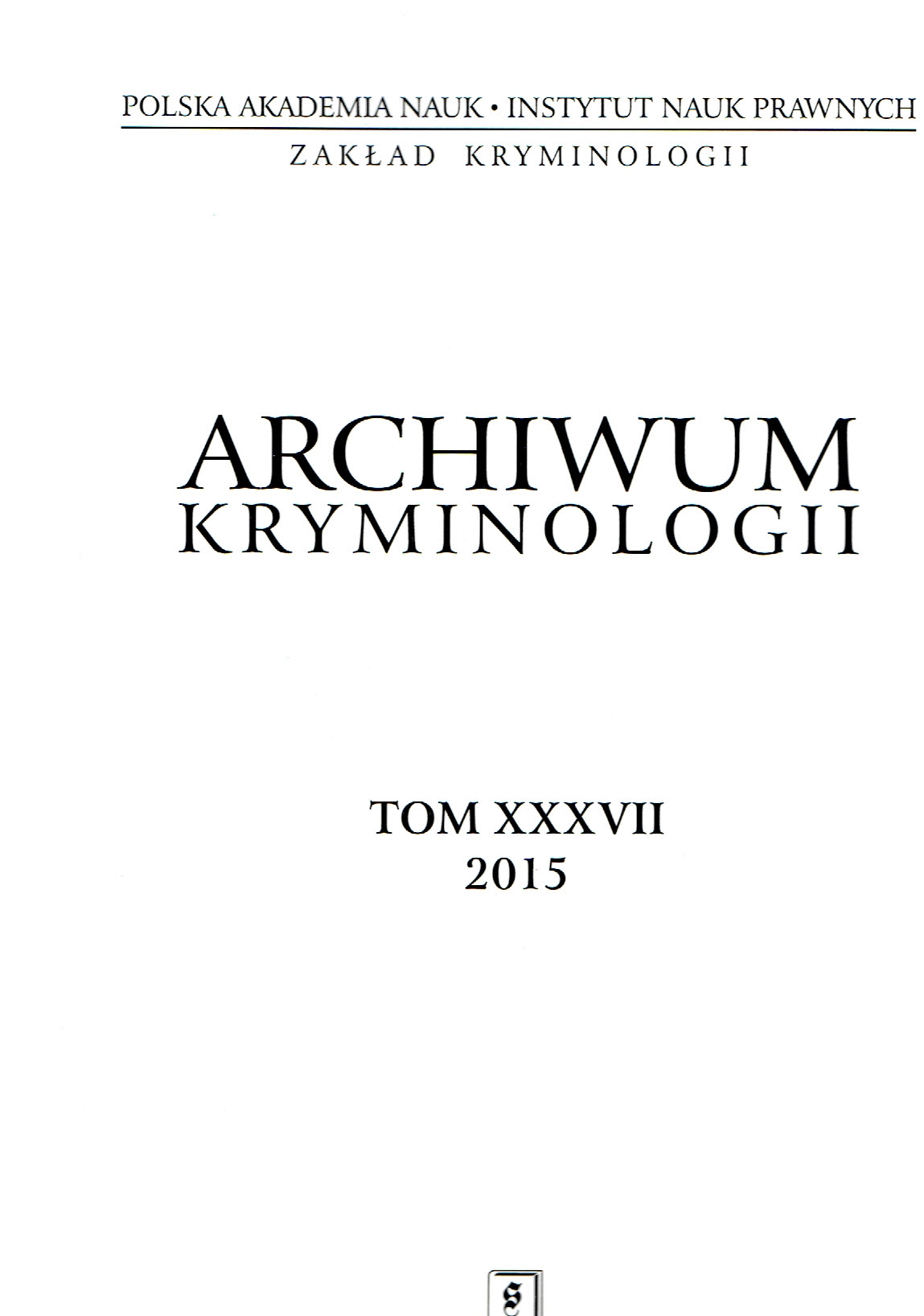CHARAKTERYSTYKA STANU I ZMIAN ROZMIESZCZENIA WYBRANYCH PRZESTĘPSTW W SZCZECINIE Z WYKORZYSTANIEM GEOSTATYSTYCZNEJ ANALIZY GIS
Analysis of the State and Change in Crime Distribution in Szczecin Using GIS Geostatic Methods
Author(s): Natalia Sypion-DutkowskaSubject(s): Law, Constitution, Jurisprudence, Criminal Law
Published by: Instytut Nauk Prawnych PAN
Keywords: przestępstwo, analiza GIS
Summary/Abstract: The aim of the article is to analyse the state and change in distribution of three types ofcrime (fights and beatings, domestic crimes, and automobile crime) in Szczecin duringthe years 2006-2010. It posits the following research questions: 1. Which type of crimes displayed a greater susceptibility to a spatial concentration? 2. Are there spaces with a higher intensity (density) of crimes and others free ofcrimes, and where are they? 3. Do spaces with a higher intensity (density) of crimes display spatial stability? The analysis makes use of geo-coded data points for crimes made available by Szczecin City Police Headquarters (crime, street, building number). It made useof geostatic methods with GIS programming, such as: Kernel density estimation;cartogram density maps (determining spaces with low and high crime densities); rangemethods (determining spaces with a lasting presence of the types of crimes found inhigh density spaces); chorochromatic methods (a map presenting only spaces witha persistent presence of the analysed types of crimes). Next, as a measure of the spatial concentration of crime, acknowledging changes in their reach and independent of theirnumber, the analysis found indicators of the concentrations for types of crime, whichenabled the author to provide answers to research questions and formulate conclusions. Maps showing low and high concentrations of fights and beatings revealedsignificant distribution and a certain spatial instability in built-up areas in Szczecin. They occured in the years 2006-2009 in around 20 spaces of varied size: one sprawlingaround the city centre, two or three medium-sized, and dozen or so small points. In theyears 2009-2010, spaces displaying fights and beatings had spread out onto the blockestates lying in the western part of the city, while they had practically vanished from thePrawobrzeże area and the north. In 2010, there were only around 15 spaces displayingthis crime in Szczecin.Maps showing low and high densities of domestic crime display focus and spatialstability in built-up areas in Szczecin. They appear in the years 2006-2009 in onlythree to six (not counting two or three that are completely insignificant) spaces ofvarious size. The largest appears in the city centre as well as neighbouring densely-builtresidential areas. They are all densely-built spaces next to streets from the end of the 19th century, or block estates mainly from the 1970s and 1980s. The second space displayingdomestic crimes encompasses the Majowe and Słoneczne block estates in Prawobrzeże, although its range is gradually decreasing. There is a striking lack of domestic crimesin significant numbers amongst the social problems in the post-industrial Skolwin and Stołczyn settlements. Located just south is Warszewo, where there is a quickly-growingexpansion of new residential developments, and it too is free from domestic crime. Maps showing low and high concentrations of vehicular crime display significantfocus and spatial stability in built-up areas in Szczecin. They appear in 2006 in seven, in 2007-2009 in three, and in 2010 in two (not counting one or two completely insignificant) spaces of various size. The largest, similarly to the case of domesticviolence spots, occur in the city centre and its neighbouring built-up areas. Theyare also all densely-built spaces next to streets from the end of the 19th century, orblock estates mainly from the 1970s and 1980s. The second space showing a lastingpresence of vehicular crime is the location of the Majowe and Słoneczne blocks in Prawobrzeże. Much like in the case of domestic crime, they do not appear amongst thesocial problems counted in the post-industrial estates of Skolwin and Stołczyn. Insteadthey appear slightly south of them in the quickly-growing new residential expansionin Warszewo. In 2006, the most strongly concentrated were fights and beatings, thenslightly less were vehicular crimes, and significantly less was domestic crime. In 2010,the most concentrated were fights and beatings, then domestic crime, and then leastwas vehicular crime. Areas of high density in all the studies of crime are concentrated in Szeczin’s citycentre and neighbouring residential areas and they take up approximately in squarekilometres the respective: one of fights and beatings, through two and a half of domesticcrimes, to around three and half in vehicular crime. The areas all overlap, and oneshared area where all appear spans around one square kilometre. This region also indicates a significant lasting presence. Other types of crime are equally concentrated. The remaining areas of Szczecin are free of a significant intensity of this type of crime. A cause of this state of affairs is most likely the focus and overlapping ofdeterminants of crime, both spatial (communal dwellings, alcohol vendors, commercialbuildings) and social (unemployment, poverty, lifelong helplessness, alcoholism, family dysfunction, lack of social controls, acceptance of criminal behaviour). An additional factor favourable to crime in the centre of every large city is the large flow of peopleand their anonymity. Szczecin’s city centre, however, indicates a significant persistencein the incidence of criminogenic factors. The quarters of Szczecin’s city centre developments located within the “criminalsquare kilometre” between Pope John Paul II Alley, Tkacka Street, Port Gate Square,Kaszubska Street, Mariana Langiewicz Street, Kazimierz Pułaski Street, Bolesław ŚmiałyStreet, July 5th Street, Grey Ranks Square and Wielkopolska Street demand particularoversight by police. Taking the long view, they ought to be revitalised in a mannermore complex than before, resulting in building local community ties, improving thematerial situation of the inhabitants as well as that of the buildings’ technical state,spatial order and visual attractiveness.
Journal: Archiwum Kryminologii
- Issue Year: 2015
- Issue No: XXXVII
- Page Range: 303-326
- Page Count: 24
- Language: Polish

